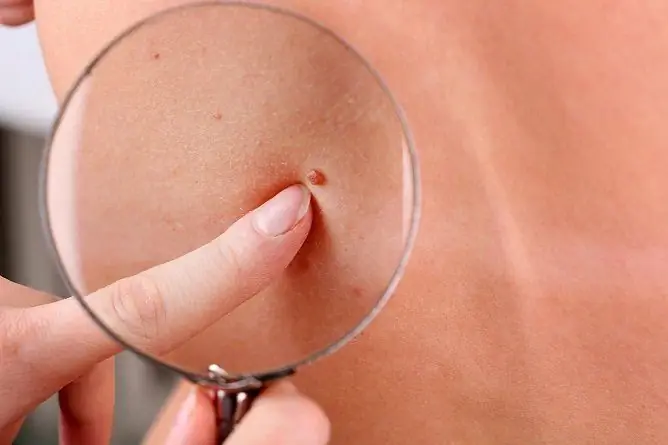- Author Rachel Wainwright [email protected].
- Public 2023-12-15 07:39.
- Last modified 2025-11-02 20:14.
Aphthae
The content of the article:
- Causes and risk factors
- Forms of the disease
- Symptoms
- Features of aft in children
- Diagnostics
- Treatment
- Possible complications and consequences
- Forecast
Aphthae (from ancient Greek. Aphtha - "ulcer") - small ulceration of the mucous membrane, more often the oral cavity, less often - the genitals, gastrointestinal tract, conjunctiva.
Aphtha has a characteristic appearance: a vesicle, which within a short time transforms into a painful erosion or ulcer, covered with a yellowish-gray fibrinous exudate, surrounded by a red rim. The diameter of the ulceration usually does not exceed 0.5 cm (although it is possible for several elements to merge with the formation of extensive ulcers), is located on a hyperemic base, and has a shallow crater-shaped center.
The aphthous defect completely disappears within 1-2 weeks; in the presence of a large area of the lesion, the healing time can increase to several weeks. After healing, scarring is extremely rare (only with extensive aphthae).

Afta on the lip
Causes and risk factors
The reason for the appearance of aft is not known for certain. At the moment, the following causal factors are considered as the most likely:
- viral infection (although it was not possible to isolate the virus from a biopsy specimen or blood of patients in the acute phase of the disease);
- chronic pathology of the gastrointestinal tract;
- exposure to allergens;
- autoimmune aggression;
- previous trauma to the oral cavity.
Risk factors are:
- hereditary predisposition;
- excessive neuropsychic stress;
- helminthic invasion;
- chronic inflammatory processes in the oral cavity;
- taking certain medications.
Although aphthous stomatitis can appear at any age; usually it debuts at 20-40 years old, among women, the incidence is higher. Family cases are quite frequent: in 12-80% of patients (according to various sources), at least one of the family members also suffers from this disease or has suffered in the past.
Systemic diseases associated with recurrent aphthous mucosal ulceration include:
- Behcet's disease (chronic vascular disease of the arterial and venous bed of various caliber);
- Sweet's syndrome (acute non-infectious skin lesions);
- Crohn's disease (chronic total autoimmune damage to the intestinal wall);
- nonspecific ulcerative colitis;
- celiac disease (congenital intolerance to gluten and cereal proteins close to it in structure);
- HIV infection;
- malabsorption syndromes;
- B12, folic and iron deficiency anemia;
- neutropenia;
- foot and mouth disease;
- sprue (tropical aphthae);
- PFAPA syndrome (a combination of recurrent fever, aphthous stomatitis, pharyngitis, and adenopathy); and etc.

Aphthae can be a symptom of many conditions, including Crohn's disease
In this case, aphthae are considered as one of the symptoms of the disease.
Forms of the disease
Aphthae can be an independent disease (aphthous stomatitis) or one of the manifestations of another, general pathology.
Aphthous stomatitis is the most common disease in which characteristic ulceration is observed. It is recurrent in nature, with periods of remission ranging from several months or weeks to several years. It is the most common oral mucosa disease, affecting approximately 5-10% of the population. Ulcerations are localized more often on the lateral surfaces and the tip of the tongue, lips, mucous membrane of the cheeks, floor of the mouth and hard palate.
Clinical forms of aft:
- small (from 3 to 6 mm in diameter, healing time - from 6 to 10 days);
- large (from 10 to 20 mm, heal within a few weeks);
- herpetiformis (from 1 to 3 mm, multiple, heal up to 2 weeks).
Symptoms
Typical signs of aft:
- local edema and hyperemia of the mucous membrane on the eve of the onset of aphtha (sometimes pallor, anemic spots are noted);
- simultaneous appearance of 1-2 (more rarely - several) limited inflammatory defects of a round or oval shape with a bright red clear outline;
- severe pain, burning, pulsation at the site of localization of the aft;
- increased salivation;
- loss of appetite, difficulty eating;
- deterioration in general health;
- with a large area of the lesion - an increase in body temperature to subfebrile numbers - 38.5-39 ºС;
- an increase in regional lymph nodes;
- headache.
In rare cases, the simultaneous appearance of aphthae in the oral cavity and on the genitals, conjunctiva of the eyes is possible.
Features of aft in children
In newborns of the first 2-3 weeks of life, bilateral aphthae of the hard palate are sometimes observed, which, merging, form a characteristic butterfly shape. The process of formation of aft in this case is provoked by mechanical damage to the oral mucosa during its processing. Such aphthous stomatitis is called Bednar's aphthae.
Diagnostics
There are no specific methods for diagnosing the disease; the diagnosis is confirmed by a characteristic clinical picture.
Treatment
Treatment for aphthae is aimed at the underlying disease (unless we are talking about aphthous stomatitis).
Treatment of aphthous stomatitis in the long term does not seem to be satisfactory enough, since, while allowing the acute process to be stopped, it does not affect the intensity and frequency of relapses, since neither the etiology nor the pathogenesis of the disease is fully understood.

Mouthwash with antiseptics is part of the complex aft treatment
The main therapeutic measures:
- a gentle diet during an exacerbation;
- topically - antiseptics, proteolysis inhibitors, necrolytic, analgesic, anti-inflammatory drugs, reparants;
- immunomodulatory therapy;
- desensitizing drugs;
- vitamin therapy;
- with deep scarring ulcer defects - glucocorticosteroid hormones.
Possible complications and consequences
Aphthae can be complicated by the following conditions:
- disease progression;
- accession of a secondary infection.
Forecast
Favorable. With an exacerbation of the process, the patient experiences some deterioration in the quality of life, fully recovers after recovery.
YouTube video related to the article:

Olesya Smolnyakova Therapy, clinical pharmacology and pharmacotherapy About the author
Education: higher, 2004 (GOU VPO "Kursk State Medical University"), specialty "General Medicine", qualification "Doctor". 2008-2012 - Postgraduate student of the Department of Clinical Pharmacology, KSMU, Candidate of Medical Sciences (2013, specialty "Pharmacology, Clinical Pharmacology"). 2014-2015 - professional retraining, specialty "Management in education", FSBEI HPE "KSU".
The information is generalized and provided for informational purposes only. At the first sign of illness, see your doctor. Self-medication is hazardous to health!






